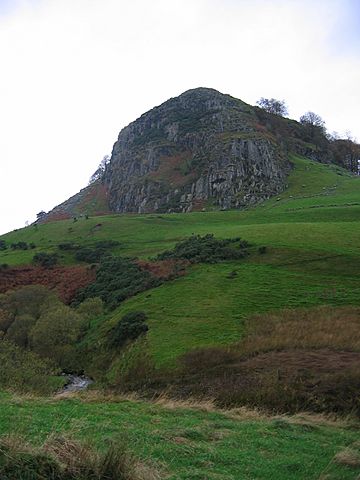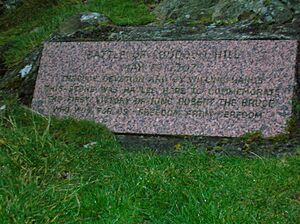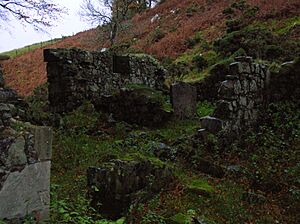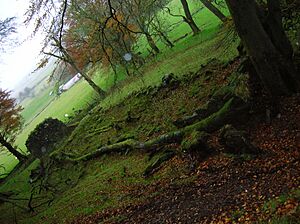Loudoun Hill facts for kids
Quick facts for kids Loudoun Hill |
|
|---|---|

Loudoun Hill from the east side
|
|
| Highest point | |
| Elevation | 316 m (1,037 ft) |
| Prominence | c. 66 m |
| Geography | |
|
Lua error in Module:Location_map at line 420: attempt to index field 'wikibase' (a nil value).
|
|
| OS grid | NS608379 |
| Topo map | OS Landranger 71 |
Loudoun Hill is a cool place in East Ayrshire, Scotland. It's a special type of hill called a volcanic plug, which means it's the leftover core of an ancient volcano! You can find it near the start of the River Irvine, just east of a town called Darvel. This hill has been important for a long time, and even a real battle was fought here!
Contents
Where is Loudoun Hill?
The A71 road, which goes from Edinburgh to Kilmarnock, runs right past the bottom of Loudoun Hill. This road actually follows an old Roman road! That's right, the Romans used this path to connect the Clyde Valley to the coast of Ayrshire.
Loudoun Hill is at the highest point on this old route, making it a super important spot for looking out and controlling the area. From the top, you can see all around, even as far as the coast (about 40 kilometers away) and the Isle of Arran on a clear day!
People have lived around Loudoun Hill for a very long time. There's a settlement from the Iron Age (a time when people used iron tools) at the bottom of the hill. Close by, at a place called Allanton Beg, the Romans built a fort. Cool things like a bronze oil lamp have been found there!
An old railway, the Darvel and Strathaven Railway, used to pass by the hill. It crossed a big bridge called a viaduct, but that was taken down in 1986. You can still see two parts of a bridge over a small road.
William Wallace and the Hill
You might have heard of William Wallace, a famous Scottish hero. A long poem called The Wallace says that William Wallace surprised and beat an English army at Loudoun Hill in 1296. This was during the Wars of Scottish Independence, when Scotland was fighting for its freedom from England.
However, most historians now think this story isn't true. It's a great legend, but probably didn't happen exactly that way.
Even so, there's a place near Loudoun Hill called 'Wallace's Grave' on maps. People traditionally say this is where the English soldiers who died in the legendary battle were buried, not Wallace himself. On the other side of the hill, there's a big monument to Wallace. It's called the 'Spirit of Scotland' and shows an outline of Wallace made from steel, standing five meters tall! A local artist named Richard Price created it, and it was officially opened in 2004.
The Battle of Loudoun Hill (The Real One!)
The real Battle of Loudoun Hill happened much later, in 1307. This was a very important victory for Robert the Bruce, who later became King of Scotland. After hiding for a while, Bruce began fighting to win his kingdom back from Edward I of England. He had just won a smaller battle at Glen Trool in April 1307.
Robert the Bruce chose almost the same spot near Loudoun Hill for another fight against the English. This time, the English army was led by Aymer de Valence, 2nd Earl of Pembroke. On May 10, Bruce's men dug a series of trenches. These trenches forced the English soldiers towards soft, boggy ground near a place called Loch Gait.
This clever plan helped Bruce's smaller army of about 500-600 Scots defeat a much larger English army of 3000! The first English attack failed, and they ran away from the battlefield. After this big win, Bruce left his brother Edward Bruce in charge of the area and went north to keep fighting.
Covenanters and Drumclog
Loudoun Hill was also important during another time in Scottish history, in the 1600s. On June 1, 1679, a large outdoor religious meeting, called a conventicle, was held at Loudoun Hill. These meetings were organized by the Covenanters, who were a group of people who wanted to practice their religion freely, but they were outlawed by the government.
John Graham of Claverhouse, who was in charge of stopping these religious rebels, heard about the meeting. He rode to the area to break it up. But his attempt led to a fight known as the Battle of Drumclog. In this battle, Claverhouse's soldiers were badly beaten! The battle site is about 1 kilometer east of Loudoun Hill. This battle is even mentioned in a famous book called Old Mortality by Walter Scott.
Rock Climbing at Loudoun Hill
Loudoun Hill is a popular place for rock climbing! It's one of the few places in central Scotland with good rocky spots for climbing. If you're interested in rock climbing, you can find information about Loudoun Hill on websites like Scottish Climbs and UK Climbing.
Farming Around the Hill
For many, many years, people farmed the land around Loudoun Hill very carefully. Old maps show that there used to be two farms, Underhill and Backhill, that were abandoned sometime between the 1800s and 1900s.
The ruins of these old farms are still standing today. They even provide shelter for the sheep from other farms that still graze on Loudoun Hill and the fields nearby.




